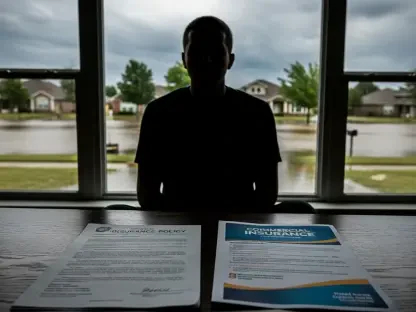A significant uptick in insurance fraud has emerged in the UK as an alarming trend, with 2023 seeing a marked increase in deceptive claims. This unsettling phenomenon, documented by the Association of British Insurers, has seen fraudulent claims amounting to £1.1 billion, which is a 4% increase from just a year before. This rise, encompassing approximately 4,400 claims with an average value of £13,000, has been attributed largely to the UK’s cost-of-living crisis. The crisis has driven desperate individuals and organized fraud networks to exploit both personal and commercial insurance systems, revealing vulnerabilities within the industry that require immediate attention.
The Landscape of Insurance Fraud in the UK
Personal Insurance Fraud Trends
Recent trends in personal insurance fraud are characterized by increasingly sophisticated schemes. Fraudsters often embellish the extent of damages or fabricate incidents entirely to claim undue compensation. These fraudulent claims have placed insurmountable pressure on insurance companies, forcing them to develop more intricate verification processes. Notably, the rise in personal insurance fraud not only impacts insurers financially but also affects consumers who face higher premiums as a result of these deceitful activities. Consequently, the industry is turning to technology, such as machine learning algorithms and artificial intelligence, to enhance fraud detection capabilities. Despite these advancements, the brazen persistence of fraudsters requires insurers to remain vigilant and adaptive to emerging threats.
Collaboration among stakeholders has become paramount. Insurance companies are now working closely with regulators, law enforcement, and fraud prevention agencies to devise comprehensive strategies for tackling this issue. Moreover, awareness campaigns are being launched to educate consumers about the risks and consequences of engaging in fraudulent activities. These combined efforts aim to create a deterrent effect, discouraging potential fraudsters and protecting honest policyholders from bearing the brunt of increased premiums. However, the battle is far from over, as fraudsters continuously modify their tactics in response to industry countermeasures.
Challenges Faced by Commercial Insurers
Commercial insurers face unique challenges as they grapple with sophisticated scams such as cash-for-crash and ghost broking. Scammers orchestrate accidents to claim damages or sell fraudulent policies, exploiting loopholes in the system. The prevalence of these scams poses significant financial risks to insurers and has far-reaching implications. Commercial fraud is further complicated by the existence of organized crime groups that establish fake companies or misrepresent business activities, seeking cheaper premiums. These operations are intricate, with extensive networks and elaborate setups that can be difficult to dismantle.
The industry’s response must be robust, involving comprehensive investigations and strategic partnerships among insurers, legal forces, and regulatory bodies. Insurers are investing in advanced data analytics to detect anomalies that indicate fraudulent activities, while simultaneously enhancing training programs to equip assessors with the skills necessary for identifying red flags. Cooperation with international agencies is also crucial, given the cross-border nature of many commercial fraud schemes. A concerted global effort is required to combat this ever-evolving threat, safeguarding not just insurers but the integrity of the insurance industry itself.
Strategies to Combat Insurance Fraud
Importance of Early Detection and Collaboration
Early detection and collaboration are critical in tackling insurance fraud effectively. With fraudsters becoming increasingly adept at evading detection, insurance companies are deploying cutting-edge technology to stay ahead. Advanced analytics and predictive modeling are being used to scrutinize claims quickly, pinpoint inconsistencies, and identify fraudulent patterns. This technological prowess, however, must be complemented by collaboration. Insurers, brokers, and law enforcement agencies must unite, sharing data and insights to form a more comprehensive view of fraudulent activities. Cooperation at every level enhances the industry’s ability to respond swiftly and decisively to fraud attempts.
Insurance brokers are positioned as the first line of defense, playing a pivotal role in this collaborative approach. They are trained to identify suspicious activities, such as discrepancies in applications or unusual requests for coverage. Their vigilance can thwart fraud attempts before they cause significant harm. By fostering a culture of transparency and accountability, the industry can bolster its defenses against the pervasive threat of fraud. Furthermore, partnerships with technology firms enable insurers to access cutting-edge tools that enhance fraud prevention capabilities. These dynamic collaborations create an ecosystem where information flows seamlessly, aiding in the identification and prosecution of fraudsters.
The Role of Public Awareness and Education
Public awareness and education are indispensable in the fight against insurance fraud. Raising awareness about the consequences of fraudulent actions plays a crucial role in deterring potential fraudsters. Public campaigns, social media initiatives, and community outreach programs serve as platforms to disseminate information on identifying fraud signs. By informing the public, insurers aim to foster a keen awareness among policyholders, turning educated consumers into allies in detecting fraudulent activities. Additionally, educational resources help demystify insurance processes, reducing the chances of unwitting complicity in fraud schemes.
An informed public also drives a cultural shift, where honesty and transparency become the norms rather than exceptions. Moreover, educational initiatives targeting youth are gaining traction, equipping the next generation with the knowledge needed to engage ethically with insurance services. These efforts have long-term benefits, fostering a resilient culture that can withstand the challenges posed by evolving fraud tactics. Community engagement further strengthens the relationship between insurers and policyholders, creating a cooperative front against crime. Ultimately, these educational and awareness endeavors ensure a holistic approach to fighting insurance fraud, benefiting consumers and the industry as a whole.
Towards a More Secure Insurance Future
In the UK, a troubling rise in insurance fraud has become apparent in 2023, marking a significant increase in dishonest claims. According to the Association of British Insurers, fraudulent claims have surged to a staggering £1.1 billion—showing a 4% increase compared to the previous year. This expansion spans roughly 4,400 claims, each averaging about £13,000. A major factor driving this escalation is the UK’s cost-of-living crisis, which has compelled both individuals and organized fraud rings to target weaknesses within the personal and commercial insurance sectors. The rising tide of fraud exposes significant vulnerabilities within the insurance industry, demanding immediate intervention and reassessment of procedures. As inflation impacts living costs and financial pressures mount, some people and groups are resorting to deceitful insurance activities as a desperate measure, illustrating the urgent need for enhanced regulatory scrutiny and preventive strategies to safeguard the system against exploitation.









